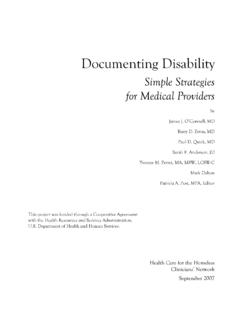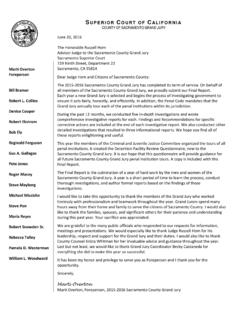Transcription of Bridging the Gaps between Criminal Justice and …
1 1 Bridging the Gaps between Criminal Justice and mental health Summit February 5, 2015 Dublin, Ohio Sequential Intercept Strategic Planning Report Ohio Prepared by: Policy Research Associates, Inc. Dan Abreu, , , Patricia Griffin, March 13, 2015 2 Table of Contents Executive Summary .. 3 Introduction .. 4 Summit Goals .. 5 Background .. 5 7 Intercept 1 Strengths and Gaps .. 9 Intercepts 2 & 3 Strengths and Gaps .. 11 Intercepts 4 & 5 Strengths and Gaps .. 13 Recommendations .. 16 References .. 22 APPENDICES Appendix A: Participant List Appendix B: CCOE Mapping Handout Appendix C: CCOE Mapping Priorities Handout Appendix D: Ohio SIM Projects Grid Appendix E: Final MAP Program Brief Appendix F: TCM Program Brief Appendix G: Jail Data Link Appendix H: Best Practices Exiting Criminal Justice Settings Appendix I.
2 Peer Advocacy 3 Executive Summary The National Alliance on mental Illness of Ohio, with the support of funding from the Ohio Office of Attorney General, Mike DeWine, contracted with Policy Research Associates (PRA) to provide a strategic planning workshop to inform the work of Attorney General s Task Force on Criminal Justice and mental Illness. The Bridging the Gaps between Criminal Justice and mental health Summit was held February 5th, 2015 at the Embassy Suites in Dublin, Ohio. There is a longstanding recognition that persons with behavioral health disorders are over-represented in the Criminal Justice system and once in the Criminal Justice system are subject to worse outcomes including being less likely to make bail, higher rates of disciplinary infractions and longer length of stay.
3 In addition, incarcerated populations have higher prevalence rates of medical conditions and substance abuse. This Summit was convened to address these disparities and to introduce the Sequential Intercept Model as a planning tool to strategically inform legislation, policy, planning, and funding. The workshop served to identify opportunities for coordination and collaboration among state and local stakeholders, inform state and local stakeholders about best practices in the behavioral health and correctional fields, and to consider the impact of health care reform, Ohio SB 43, Outpatient Treatment Law and state behavioral health and Criminal Justice initiatives on Justice -involved populations.
4 The Sequential Intercept Strategic Planning workshop has three primary objectives: 1. Development of a comprehensive picture of how people with mental illness and co-occurring disorders flow through the Criminal Justice system along five distinct intercept points: Law Enforcement and Emergency Services, Initial Detention and Initial Court Hearings, Jails and Courts, Re-entry, and Community Corrections/Community Support. 2. Identification of gaps, resources, and opportunities at each intercept for individuals in the target population. 3. Development of priorities for activities designed to improve system and service level responses for individuals in the target population.
5 Recommendations: 1. Expand Crisis Care Continuum 2. Continue to expand CIT initiatives and CIT program development 3. Expand the Role of the Ohio Criminal Justice Coordination Center of Excellence (CJ CCOE) 4. Educate and train on use of court-ordered outpatient treatment, SB43 5. Expand Pre-trial Services and Early Diversion Opportunities 6. Continue to support the expansion of specialized dockets 7. Develop a Statewide Strategy to Assist Counties in Using Technology to Improve Jail Screening for Persons with mental Illness 8. Insure Planning and Implementation of Medicaid Expansion, health Home Implementation and Ohio SB 43 Outpatient Treatment Law Address the Specific Needs of Justice -Involved Persons with Behavioral health Disorders 9.
6 Expand and enhance successful Criminal Justice and Behavioral health Programs 9a . Implement a prison based Social Security Access and Recovery (SOAR) initiative 9b. Utilize the CJ CCOE to facilitate replication and expansion of programs 10. Broaden and formalize county level Criminal Justice /behavioral health planning committees 4 Acknowledgement PRA wishes to thank Betsy Johnson from the National Alliance on mental Illness of Ohio for her assistance with the coordination of this event. In addition, we would like to thank the following individuals for sharing their expertise in the planning of the Summit: Fred Frese, Deb Herubin, Tereasa Jamison, Mark Munetz, Chris Nicastro, Michael Sheline, Ruth Simera, and Evelyn Stratton.
7 Introduction: The National Alliance on mental Illness of Ohio, with the support of funding from the Ohio Office of Attorney General, Mike DeWine, contracted with Policy Research Associates (PRA) to provide a strategic planning workshop to inform the work of Attorney General s Task Force on Criminal Justice and mental Illness. The Bridging the Gaps between Criminal Justice and mental health Summit was held February 5th, 2015 at the Embassy Suites in Dublin, Ohio. Persons with mental illness and co-occurring disorders are over represented in the Criminal Justice system. Steadman, et. al.
8 (2009) found that the prevalence of people with serious mental illness is 3 times higher than the general Teplin, et. al. (1991) found that 72% of jail inmates have a co-occurring Other characteristics of Justice involved individuals with mental illness are: They are less likely to make They are more likely to have longer pre-trial incarceration. 3 They are more likely to have serious disciplinary issues in jail or They are more likely to face technical probation violations. 5 Trauma lifetime prevalence rates for persons with mental illness are over 90% (unpublished TAPA data).
9 Trauma incurred within the year prior to arrest is over 70% (unpublished TAPA data). They have higher rates of homelessness, unemployment, and substance abuse. 4 Across the Criminal Justice system, persons with mental illness fare worse than those without. In addition, incarcerated populations have higher prevalence rates of medical conditions and substance abuse: Tuberculosis 4 times higher Hepatitis C 9-10 times higher HIV 8-9 times higher Substance Abuse It is not surprising then, that a study of Washington state prison releases found that within 90 days of release the mortality rate for the cohort was 3 times higher than the general population and within 2 weeks of release, the mortality rate was 12 times higher than the general population.
10 6 Ohio has addressed the issues of mental illness in the Criminal Justice system head on. There are robust initiatives across the Criminal Justice system. Ohio is one of the national leaders in development of Police Crisis Intervention Teams, mental health Courts and Veterans Justice Initiatives. The Ohio Department 1 22 5 of Rehabilitation and Corrections has substantially enhanced reentry planning initiative and the Ohio Department mental health and Addictions funds a broad range of diversion and reentry initiatives. The Attorney General s Task Force on mental illness and Criminal Justice has provided for proactive state planning and this Summit provides an opportunity to identify critical areas to address.




